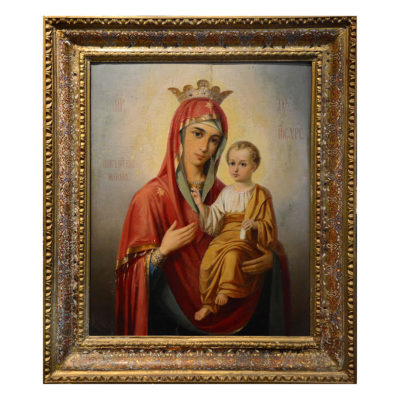
| SKU | PF.5959 |
|---|---|
| Circa | 19th Century AD to 20th Century AD |
| Dimensions | 35.75″ (90.8cm) high |
| Medium | Wood |
| Origin | Russia |
| Gallery Location | USA |
Russians inherited the tradition of icon painting from Byzantium, where it began as an offshoot of the mosaic and fresco tradition. During the 8th and 9th centuries, the iconoclastic controversy in the Orthodox Church called into question whether religious images were a legitimate practice or sacrilegious idolatry. Although the use of images was in the end permitted, a thorough distinction between profane art intended to depict reality and sacred art designed for spiritual contemplation was established. That difference is one of the reasons that the artistic style of icons can seem so invariant. Certain kinds of balance and harmony became established as reflections of divinity, and as such they invited careful reproduction and subtle refinement rather than striking novelty. Although this philosophy resulted in a comparatively slow evolution of style, icon painting evolved considerably over the centuries. Unlike the pictorial traditions of the west that aspire towards increased realism and naturalism, the essence of Russian icon painting is not about the representation of physical space or appearance. Icons are images intended to aid in contemplative prayer, and in that sense, are more concerned with conveying meditative harmony than with laying out a realistic scene. They were not painted to please the eye of the mind, but to inspire reflection and self-examination.
This gorgeous painting reflects the influence of western European art on the Russian tradition. Both the folds of the drapery and the curvature of the body are rendered with heightened naturalism. However, the added realism does not detract from the subject’s divine nature. Instead, the viewer is able to identify with the figures on an increasingly personal level. The artist has rendered these supernatural figures in a style that is both intimate and personal. While the painter has captured the Virgin and Christ child’s humanity, he has been careful to suggest their divinity. A pale yellow light radiates from around the heads of both figures, encircled by subtle halos. The infant Christ holds a wound up scroll in one hand and forms a sign of benediction with the other. The virgin is cloaked in sumptuous robes befitting the Mother of God. She is crowned with a jeweled tiara suggesting her role as the Queen of Heaven. The collar and cuffs of her blue blouse are also studded in pearls and gems. These refined decorations suggest her holiness and importance. She gestures towards her son as if to remind the viewer to focus not on the luxury of heaven, but on the pathway to righteousness as personified by Christ. This stunning painting updates the traditional style of icon painting. The artist has succeeded in maintaining the essential spirituality of the subject while naturalizing the forms of the figures, creating an image that we are both drawn into and in awe of.
Signed by Davidof of the Moscow School
Login to view price
Sign-up to receive the latest Wedding Estates news and promotions!

